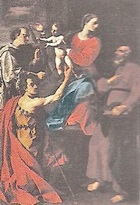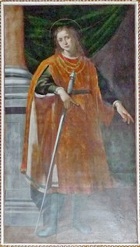

Andrea Polinori was born in Todi, where his important clients included Bishop Angelo Cesi and Bishop Marcello Lante. He spent a formative period in Rome in ca. 1615.
His brother, Giovanni Antonio Polinori, was also an artist.
Todi
Works in the Pinacoteca
The following works are now in the Pinacoteca:
Madonna and Child in glory with saints (1608)
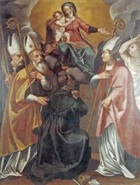
Apparition of Christ (1635)
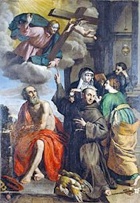
Madonna and Child in glory with saints (1635)

Vision of St Antony of Padua (1635)
The Compagnia dei Sarti (Tailors’ Guild) commissioned this altarpiece for their chapel in the now-demolished church of San Giacomo dei Sarti. Their patron, St Homobonus (with a pair of tailor’s scissors on his right) witnesses the vision, in which the Madonna passes the baby Christ to the praying St Antony.
Work in San Fortunato
The following works survive in San Fortunato:
Cappella dell’ Assunta (1617)
Mercurio Accursi commissioned Andrea Polinori to redesign and decorate this chapel. The works in it include:
-
✴the altarpiece (1620) of the Presentation of the Virgin at the Temple, above the altar on the left wall, with a fresco of the birth of the Virgin in the lunette above it;
-
✴the altarpiece (1620) of the Trinity and the Coronation of the Virgin, above the altar on the right wall, with a fresco of the Annunciation in the lunette above it; and
-
✴other frescoes (1620), which include figures of Moses, David, Solomon and Jeremiah (in the pendentives below the cupola) and SS Peter and Paul (on the entrance arch).
Coronation of the Virgin with saints (1618)
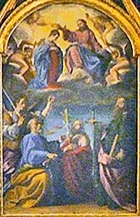
Works in the Nunziatina
In 1602, Bishop Angelo Cesi gave the small church of Sant’ Angelo on this site to the Compagnia della Santissima Annunziata. They demolished it, and having acquired adjoining properties, they built the present church of the Nunziatina on the enlarged site. Unfortunately, much of its original decoration was destroyed in a fire in 1700. The church has recently been restored.
Surviving works in the church by Andrea Polinori include:
-
✴the fresco (1627) of the Supper at Emmaus, in the right aisle;
-
✴the fresco (1627) of the Adoration of the Magi, over the door to the sacristy; and
-
✴the altarpiece (17th century) depicting Jacopone da Todi, on the 2nd altar on the right.
Works in San Nicolò de Criptis
The surviving works by Andrea Polinori in San Nicolò de Criptis include:
-
✴the panel (1644) of St Terentius in Adoration of the Eucharist, in the 1st bay on the left;
-
✴the panel (early 17th century) of the Madonna dei Pellegrini, on the right wall of the presbytery, which is a copy of an altarpiece (1603-5) by Caravaggio in Sant’ Agostino, Rome; and
-
✴detached frescoes (17th century) of SS Peter and Paul, on the sides of the arch of the presbytery, which came from the nearby church of la Madonnuccia.
Other Works in Todi
Portrait of Blessed Antony Vici of Stroncone (1612)
This full-length portrait is in Santa Maria di Montesanto, on the back wall of the Cappella della Crocifissione, to the right of the altar. It forms a pendant to a portrait (1612) of Blessed John Vici of Stroncone by Pietro Paolo Sensini.
SS Benedict and Theresa of Avila (1621)
These panels are on the counter-façade of Santa Prassede. The inscription on the panel of St Benedict records that they belonged to a series of four, and other documents record that this was commissioned for the Cappella di Confraternita della Madonna del Carmine in San Silvestro:
-
✴The panel of St Scholastica remains in San Silvestro;
-
✴that of St Francesca of Rome has been lost; and
-
✴these other panels from the series were moved here in 1987 when San Silvestro was closed.
Holy Family in St Joseph’s workshop (1623)
The Confraternita dei Falegnami (Carpenters’ Guild) brought this altarpiece from Sant’ Antonio to the high altar of their new church, San Giuseppe dei Falegnami in 1643. It is one of Polinori’s finest paintings.
Deposition, with allegories of Abundance and Justice (1633)
This fresco by Andrea Polinari is on the back wall of the ex-headquarters of the Monte di Pietà (the building to the left of the Chiesa del Monte di Pietà, which now houses the Post Office).
Miracle at San Domenico in Soriano (17th century)
This altarpiece [by Andrea Polinari] in Santa Maria in Camuccia (in the 1st chapel on the left) depicts a miracle that occurred in 1530 at the sanctuary of San Domenico at Soriano in Calabria, when the Virgin and SS Mary Magdalene and Catherine of Alexandria appeared to one of the brothers and gave him an image of St Dominic. (The saint in the image is sometimes said to be St Hyacinth (San Giacinto)). Pietro Paolo Sensini probably painted the image in the altarpiece.
Frescoes (17th century)
These frescoes of SS Jerome, Gregory, Liberata, Agatha, Barbara and an unknown martyr are in San Filippo Benizi (in the 2nd chapel on the right).
Innocent III Confirms the Franciscan Rule (17th century)
This documented altarpiece from the Tempio del Santissimo Crocifisso was destroyed in ca. 1990.
Amelia
Assumption of the Virgin (1627)
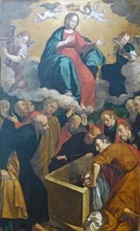
Assisi
Madonna della Cordone (17th century)
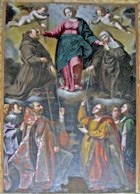
Massa Martana
Madonna del Latte with Saints (15th century)
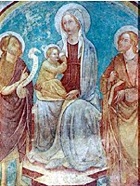
Montefalco
St Severus (17th century)
Terni
Madonna and Child with saints (1635)
